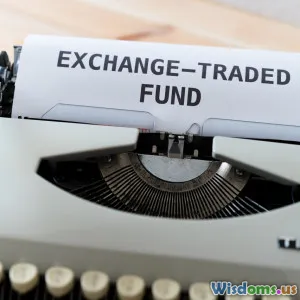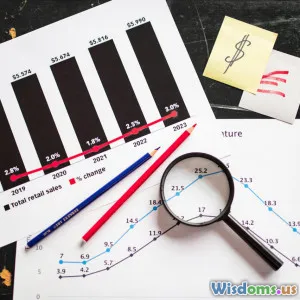
Beginner Mistakes to Avoid When Starting with ETFs
9 min read Avoid common pitfalls when investing in ETFs with practical tips for beginners to build a solid foundation in ETF investing. (0 Reviews)
Beginner Mistakes to Avoid When Starting with ETFs
Introduction
Exchange-Traded Funds, or ETFs, have revolutionized how individuals invest in the stock market. Combining the benefits of mutual funds and stocks, ETFs offer diversification, liquidity, and ease of access at a relatively low cost. However, for beginners setting foot into this dynamic space, the journey can be fraught with pitfalls. Mistakes made early on can erode returns and shake confidence. This article uncovers key beginner mistakes when investing in ETFs and offers actionable insights to get your portfolio on the right track.
The Allure and Complexity of ETFs
ETFs have surged in popularity; as of 2024, the global ETF assets surpassed $10 trillion, reflecting investors' appetite for flexible, diversified instruments. ETFs cover various asset classes: equities (U.S. & global), bonds, commodities, sectors, and even thematic niches like clean energy or robotics.
But with wide choices comes complexity. Understanding the nuances—how ETFs work, their fees, tracking methods, and tax ramifications—is essential before committing funds.
Common Beginner Mistakes When Starting with ETFs
1. Overlooking the Importance of Expense Ratios
A widespread rookie error is ignoring the expense ratio, the annual fee charged by an ETF provider. Though often deceptively small (0.04% to 0.75%), these fees compound and can significantly reduce returns over time.
Example: If you invest $10,000 in an ETF with a 0.50% expense ratio, after 20 years, your investment could be worth about $4,000 less compared to a similar ETF costing 0.10%, assuming identical returns.
Investors should favor ETFs with low expense ratios but also understand that the cheapest is not always best—quality and tracking accuracy matter.
2. Neglecting to Research Underlying Indexes
ETFs typically track specific market indexes, such as the S&P 500 or the MSCI Emerging Markets Index. Beginners often assume ETFs replicating popular indexes perform similarly, but small variations exist.
For instance, the Dow Jones Industrial Average has only 30 stocks, while the S&P 500 covers 500 large-cap companies. These differences affect exposure and risk.
Moreover, some ETFs use sampling strategies rather than owning all index components, potentially leading to tracking errors.
Tip: Always verify which index an ETF tracks and understand the index methodology to match your investment goals.
3. Ignoring Liquidity and Trading Volume
Despite ETFs being inherently liquid, not all ETFs are actively traded. Low average daily volume can lead to wider bid-ask spreads, meaning higher transaction costs when buying or selling.
Example: An ETF trading 10,000 shares daily might have a bid-ask spread of 0.05%, while an ETF trading only 1,000 shares might have a spread of 0.5%. Over time, these hidden costs can eat into profits.
Investors should look for ETFs with sufficient liquidity and tighter spreads to minimize trading costs.
4. Focusing Solely on Past Performance
It’s natural to look at historical returns, but this tunnel vision can be misleading. Market conditions shift; an ETF that performed well during a bull market might struggle in volatility.
Additionally, chasing ‘hot’ ETFs could lead to buying at peaks.
Real-World Insight: Warren Buffett once said, "Beware of past performance as a guide to the future." Look beyond returns; understand the ETF’s investment philosophy, holdings, and market environment.
5. Forgetting the Impact of Taxes
ETFs are often touted as tax-efficient compared to mutual funds because of their unique creation and redemption mechanism. However, taxes still apply, and not all ETFs are created equal in this respect.
For example, bond ETFs may distribute interest income that is taxed yearly. Certain international ETFs may incur foreign tax reporting complexities.
Ignoring potential capital gains distributions can surprise investors at tax time.
Pro Tip: Consider holding tax-inefficient ETFs in tax-advantaged accounts like IRAs when possible.
6. Lack of Diversification Despite ETFs’ Diversification Nature
While ETFs provide diversification relative to individual stocks, some investors believe buying a single ETF is adequate across the whole portfolio.
For instance, investing solely in a U.S. large-cap ETF like the SPY ignores other asset classes such as international stocks, bonds, or alternative assets.
Practical Advice: Construct a well-rounded portfolio by combining ETFs across different sectors, geographies, and asset types. This reduces risk and smooths returns.
7. Overtrading and Market Timing Attempts
The liquidity and ease of trading ETFs can lure beginners into frequent buying and selling, attempting to time markets or exploit short-term trends.
Studies show market timing often leads to poorer returns and increased taxes and fees.
Data Point: A Dalbar study found the average investor underperforms the market due to behavioral mistakes such as market timing.
8. Not Understanding the ETF Structure — Physical vs Synthetic
ETFs can replicate the index physically (buying the actual securities) or synthetically (using swaps or derivatives). Synthetic ETFs carry counterparty risks that some investors may want to avoid.
Understanding this helps in assessing risks and picking the right product, especially for complex asset classes or emerging markets.
How to Start Right: Best Practices for ETF Beginners
Define Your Investment Goals Clearly
Are you investing for long-term growth, income, or preserving capital? Identifying goals guides your choice of ETFs and asset allocation.
Conduct Thorough Research
Use resources such as Morningstar, ETF.com, or provider websites to study ETF fundamentals. Focus on the expense ratio, index, holdings, liquidity, and performance.
Diversify Thoughtfully
Build a balanced portfolio using ETFs covering domestic and international equities, bonds, and possibly alternative investments.
Be Careful With Leverage and Inverse ETFs
These products are designed for short-term trading and daily rebalancing. They are riskier and not intended for buy-and-hold investors.
Consider Costs Beyond Expense Ratios
Factor in trading commissions (though many brokers offer commission-free ETFs), bid-ask spreads, and tax implications.
Maintain a Long-Term Perspective
Resist the urge to overtrade based on market news or sentiment. Focus on disciplined investing and regular portfolio review.
Conclusion
Investing in ETFs offers beginners a gateway into the markets with flexibility and diversification not available in traditional stock picking. However, avoiding common mistakes like overlooking fees, neglecting research, and attempting to time the market can make the difference between a disappointing experience and a successful investment journey.
Arming yourself with knowledge, defining clear objectives, and practicing patience are your strongest allies. Remember, even Nobel laureate and ETF pioneer Eugene Fama noted, "Indexing, which ETFs enable cheaply and efficiently, is hard to beat in the long run."
Starting smart and steady is the key to unlocking the immense potential ETFs provide.
References
- Morningstar ETF Reports (2024)
- ETF.com - ETF Basics
- Dalbar's 2023 Quantitative Analysis of Investor Behavior
- Vanguard: Understanding Expense Ratios
- CNBC: Warren Buffett Investment Advice
Rate the Post
User Reviews
Popular Posts




















